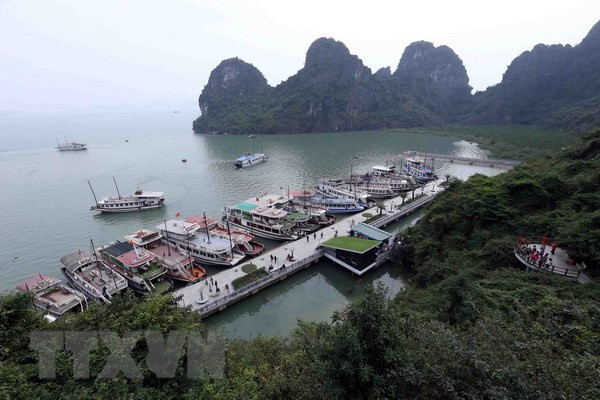QuangNinh (VNA) – Realising that a lack of infrastructure had prevented the province from fully tapping its advantages andpotential, the northern coastal province of Quang Ninh set out to research andseek the central government’s permit to carry out many large-scaleinfrastructure projects in as early as in 2010.
*Goodplanning and policies
Towardsthe goal of turning the province into a locomotive and an important growth poleof the northern key economic zone, Quang Ninh paid special attention to strategicplanning work in the direction of shifting to a green growth model.
Theprovince announced seven strategic blueprints on September 14, 2014, includinga master plan on socio-economic development to 2020 with a vision to 2030.
Basedon strategic blueprints for the sea-based and navigation economy, Quang Ninhlooked for different ways to attract investment from other sources rather thanthe public budget, including in the form of Public-Private partnership (PPP),in order to build a system of transport infrastructure, helping enhanceregional connectivity, creating motive power for economic growth in thenorthern key economic region and expanding trade linkages with countries in theAssociation of Southeast Asian Nations (ASEAN) and the world.
Since2015, the province has invested more than 30 trillion VND, with 19.8 trillionVND coming from sources other than the budget, into transport infrastructure.
Asof 2018, the province has put in place a modern and synchronous network ofroads, connecting it with other localities in the northern key economic regionsuch as Hanoi, Hai Phong, Thai Binh and Nam Dinh. It has just signed a PPP contractto construct the Van Don-Mong Cai highway worth nearly 11.2 trillion VND (474.4million USD).
Moreroads are being built
Besidestransport infrastructure, Quang Ninh has revised plans for local ports andwharves serving coal transport, thus abolishing small-scale coal wharves and storagesites along the coast of Cua Luc and Ha Long Bays as well as in Cam Pha, DongTrieu, Uong Bi and Hoanh Bo. New specialized roads have been built for coal transport,while new modes of transport such as railway and conveyor belts are beingintroduced to reduce pollution.
Theprovince also ended the transport of cement and clinker on Ha Long Bay, andrelocated residents in floating fishing villages in the bay to new homes in HaPhong ward, Ha Long city, thus improving the environment in the bay, which is aUNESCO-recognised World Heritage site.
*Goodsigns in attracting investment in sea-based economy
Thestanding board of Quang Ninh Party Committee has issued several resolutions onspecific programmes of actions to develop the sea-based economy. Theresolutions identified the key tasks for the province, which are developing thesystem of ports, port services and maritime transport; sea-based industries,coastal economic zones and industrial parks; fisheries; sea tourism; science-technologyand human resources.
Severalinvestors, both foreign and domestic, have invested in sea ports in Quang Ninh,for example the SSA Holdings International Vietnam Inc which entered into ajoint venture with Cai Lan Port Investment Joint Stock Company to build andoperate Berths 2, 3 and 4 at Cai Lan Port; and Sun Group, which poured moneyinto the Hon Gai port with the aim of turning it into an international port forcruisers.
Inlate 2016, the province also licensed the Dam Mac project, which aims to builda complex of sea port and industrial parks in Quang Yen town. The 315 millionUSD project is invested by the CDC Corporation (Cayman Islands), the Middle UtilitiesCompany Pte. Ltd (Singapore), and the Infra Asia Investment Ltd (Hong Kong).
Someother large-scale port projects have also been submitted to competent agenciesfor consideration.
Since2017, the volume of container going through Quang Ninh’s sea ports has risenagain. Local sea ports collected 10.3 trillion VND for the State budgets.
Sofar this year, sea ports in Quang Ninh handled nearly 59 million tonnes ofcargo, up 37 percent from the same period last year.
Positivedevelopment in Quang Ninh’s sea-based economy is attributable to the provincialauthorities’ sound decision to give priority to infrastructure.-VNA






























